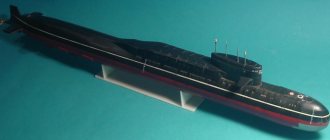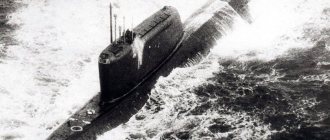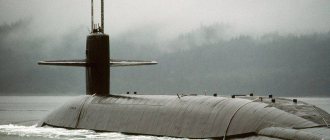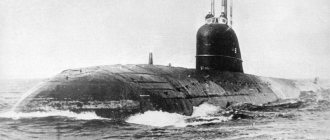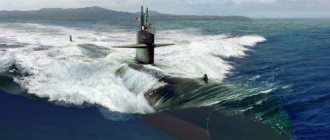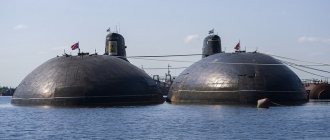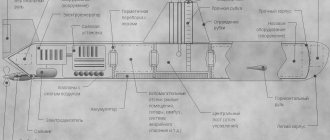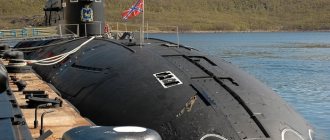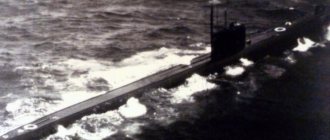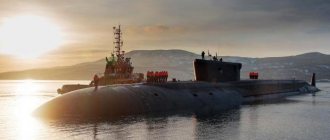Nuclear submarines with cruise missiles. Project 670 "Scat" (Charlie-I class)
In the USSR in the late 1950s. domestic designers began work on shaping the appearance of second-generation nuclear submarines intended for large-scale production. These ships were called upon to solve various combat missions, among which was the task of fighting enemy aircraft carriers, as well as other large ships. After considering several proposals from the design bureau, the terms of reference for the development of a cheap and relatively simple nuclear submarine of Project 670 (code "Skat"), which was optimized for combating surface targets, were issued in May 1960 to the Gorky SKB-112 (in 1974 renamed TsKB " Lapis lazuli"). This young team of designers, formed in 1953, had previously been involved in work on diesel-electric submarines of Project 613 (in particular, SKB-112 prepared documentation that was transferred to China), so for SKB the creation of the first nuclear-powered submarine became a serious test. Vorobiev V.P. was appointed chief designer of the project, and Mastushkin B.R. - the chief observer of the navy.
The main difference between the new vessel and the 1st generation SSGNs (projects 659 and 675) was that the submarine was equipped with the Amethyst anti-ship missile system, which has an underwater launch capability (developed by OKB-52). On April 1, 1959, a government decree was issued according to which this complex was created.
One of the most difficult problems during the development of the project for a new nuclear submarine with cruise missiles, the serial construction of which was to be organized in the very center of Russia - in Gorky, thousands of kilometers from the nearest sea, was keeping the displacement and dimensions of the ship within the limits allowed transportation of the submarine along inland waterways.
As a result, the designers were forced to accept and also “punch” from the customer some technical equipment that is unconventional for the domestic fleet. decisions that contradicted the Submarine Design Rules. In particular, they decided to switch to a single-shaft design and sacrifice the provision of surface buoyancy in the event of flooding of any watertight compartment. All this made it possible to fit within the framework of the preliminary design with a normal displacement of 2.4 thousand tons (however, during further design this parameter increased, exceeding 3 thousand tons).
Compared to other second-generation submarines, which were designed for the powerful, but rather heavy and large-sized Rubin sonar system, on the 670th project it was decided to use the more compact Kerch sonar system.
In 1959, OKB-52 developed a preliminary design for the Amethyst missile system. Unlike the first-generation Chelomeev anti-ship missiles P-6 and -35, which used a turbojet engine, they decided to use a solid-fuel rocket engine on a missile with an underwater launch. This significantly limited the maximum firing range. However, at that time there was simply no other solution, since at the technological level of the late 1950s it was not possible to develop a system for starting an air-breathing engine during flight, after the launch of a rocket. In 1961, testing of Amethyst anti-ship missiles began.
Approval of technical The project of a new nuclear submarine took place in July 1963. The Project 670 nuclear submarine with cruise missiles had a double-hull architecture and spindle-shaped contours of a light hull. The bow of the hull had an elliptical cross-section, which was determined by the placement of missile weapons.
The use of large-sized sonar and the desire to provide these systems in the aft sectors with the maximum possible viewing angles have caused the “blunting” of the bow contours. In this regard, some of the instruments were placed in the bow end of the upper part of the light hull. Horizontal forward rudders (a first for domestic submarine shipbuilding) were moved to the middle part of the submarine.
AK-29 steel was used to make a durable case. For 21 meters at the bow end, the robust hull had a “triple eight” shape, which was formed by cylinders of relatively small diameter. This form was determined by the need to place missile containers in a lightweight body. The submarine's hull was divided into seven waterproof compartments: The first compartment (composed of three cylinders) - battery, living and torpedo; The second compartment is residential; The third compartment is the battery, central post; The fourth compartment is electromechanical; The fifth compartment is the reactor compartment; The sixth compartment is turbine; The seventh compartment is electromechanical.
The end bow bulkhead and six intercompartment bulkheads are flat, designed for pressure up to 15 kgf/cm2.
Low-magnetic steel and AMG were used to manufacture a lightweight hull, a durable deckhouse and ballast tanks. Aluminum alloy was used for the superstructure and fencing of the retractable wheelhouse devices. The radomes of hydroacoustic antennas, the permeable parts of the aft end, and the stern empennage are made using titanium alloys. The use of dissimilar materials, which in some cases form galvanic couples, required special measures to protect against corrosion (gaskets, zinc protectors, etc.).
To reduce hydrodynamic noise when moving at high speeds, as well as to improve hydrodynamic characteristics, for the first time on domestic submarines, mechanisms for closing ventilation and scupper holes were used.
The main power plant (power 15 thousand hp) was largely unified with the twice as powerful power plant of the high-speed nuclear submarine of the 671st project - the single-reactor steam generating plant OK-350 included a water-cooled reactor VM-4 (power 89.2 mW). The GTZA-631 turbine drove a five-blade propeller. There were also two auxiliary electrically driven water jets (270 kW), which provided the ability to travel at speeds of up to 5 knots.
SSGN S71 "Chakra" passes next to the Indian aircraft carrier R25 "Viraat"
On the boat of the 670th project, as on other second-generation submarines, the power generation and distribution system used three-phase alternating current with a frequency of 50 Hz and a voltage of 380 V.
The ship is equipped with two autonomous TMVV-2 turbogenerators (power 2000 kW), a 500-kilowatt diesel alternating current generator with an automated remote control system and two groups of batteries (each with 112 elements).
To reduce the acoustic field of the SSGN, soundproofing damping of the mechanisms and their foundations was used, as well as lining the decks and bulkheads with vibration-damping coatings. All outer surfaces of the light hull, the wheelhouse fencing and the superstructure were covered with a rubber anti-hydrolocation coating. The outer surface of the durable body was covered with a similar material. Thanks to these measures, as well as the single-turbine and single-shaft layout, the Project 670 SSGN had a very low level of acoustic visibility for that time (among the Soviet second-generation nuclear-powered submarines, this submarine was considered the quietest). Its noise level at full speed in the ultrasonic frequency range was less than 80, in infrasonic – 100, in sound – 110 decibels. At the same time, most of the acoustic range and the natural noise of the sea coincided. The submarine had a degaussing device designed to reduce the ship's magnetic signature.
The submarine's hydraulic system was divided into three autonomous subsystems, which served to drive general ship devices, rudders, and missile container covers. The working fluid of the hydraulic system during the operation of submarines, which was a constant “headache” for crews due to its high fire hazard, was replaced with a less flammable one.
The Project 670 SSGN had an electrolysis stationary air regeneration system (this made it possible to abandon another source of fire hazard on the submarine - regeneration cartridges). The freon volumetric fire extinguishing system ensured effective fire fighting.
The submarine was equipped with the Sigma-670 inertial navigation system, the accuracy of which exceeded the corresponding characteristics of the navigation systems of first-generation boats by 1.5 times. The Kerch SJSC provided a detection range of 25 thousand meters. A BIUS (combat information and control system) “Brest” was placed on board the boat to control combat systems.
On the ship of the 670th project, compared to the first generation ships, the level of automation has sharply increased. For example, the control of the submarine's movement along the course and depth, stabilization without moving and on the move, the process of ascent and submersion, the prevention of emergency dips and trims, control of preparation for torpedo and missile firing, and the like were automated.
The habitability on the submarine has also been somewhat improved. All personnel were provided with individual sleeping places. The officers had a wardroom. Dining room for midshipmen and sailors. The interior design has improved. The submarine used fluorescent lamps. In front of the wheelhouse fence there was a shuttle pop-up rescue chamber designed to rescue the crew in an emergency (ascent from depths of up to 400 meters).
The missile armament of the Project 670 SSGN - eight Amethyst anti-ship missiles - was located in SM-97 container launchers located outside the durable hull in the front of the ship on the side at an angle of 32.5 degrees to the horizon. The P-70 solid fuel missile (4K-66, NATO designation SS-N-7 “Starbright”) had a launch weight of 2900 kg, a maximum range of 80 km, and a speed of 1160 kilometers per hour. The rocket was carried out according to a normal aerodynamic design and had a folding wing that opened automatically after launch. The missile flew at an altitude of 50-60 meters, which made it difficult to intercept it by air defense systems of enemy ships. The radar homing system for anti-ship missiles ensured automatic selection of the largest target in the order (that is, the target that has the largest reflective surface). The submarine's typical ammunition load consisted of two missiles equipped with nuclear weapons (1 kt yield) and six missiles with conventional warheads weighing about 1000 kg. Fire with anti-ship missiles could be carried out from a depth of up to 30 meters in two four-missile salvoes at a speed under the boat of up to 5.5 knots, with sea state less than 5 points. A significant drawback of the P-70 Amethyst missiles was the strong smoke trail left by the solid-fuel rocket engine, which unmasked the submarine during the launch of anti-ship missiles.
The torpedo armament of the Project 670 submarine was located in the bow of the vessel and consisted of four 533-mm torpedo tubes with an ammunition load of twelve SET-65, SAET-60M or 53-65K torpedoes, as well as two 400-mm torpedo tubes (four MGT-2 or SET-40). Instead of torpedoes, the submarine could carry up to 26 minutes. Also, the submarine’s torpedo ammunition included Anabar decoys. The Ladoga-P-670 control system was used to control torpedo firing.
In the West, Project 670 submarines were given the designation “Charlie class”. It should be noted that the appearance of new missile carriers in the USSR fleet significantly complicated life for the aircraft carrier formations of the US Navy. Having less noise compared to their predecessors, they were less vulnerable to anti-submarine weapons of a potential enemy, and the ability to launch missiles underwater made the use of their “main caliber” more effective. The low firing range of the Amethyst complex required an approach to the target at a distance of up to 60–70 kilometers. However, this also had its advantages: the short flight time of low-altitude transonic missiles made it very problematic to organize counteraction to an attack from under water from “dagger” distances.
Modifications
Five SSGNs of the 670th project (K-212, -302, -308, -313, -320) were modernized in the 1980s. The Kerch hydroacoustic complex was replaced by the new Rubicon sonar complex. Also, on all submarines, in front of the fencing of the retractable wheelhouse devices, a hydrodynamic stabilizer was installed, which was a plane with a negative angle of attack. The stabilizer compensated for the excessive buoyancy of the submarine’s “bloated” bow. On some submarines of this series, the previous propeller was replaced with new low-noise four-bladed propellers with a diameter of 3.82 and 3.92 m, mounted tandemly on one shaft.
In 1983, the K-43 nuclear-powered cruise missile submarine, slated for sale to India, underwent major overhaul and modernization under Project 06709. As a result, the submarine received the Rubicon sonar system. Also during the work, an air conditioning system was installed, new crew quarters and cabins for officers were equipped, and secret control and communications equipment was removed. After completing the training of Indian crews, the submarine was again undergoing repairs. By the summer of 1987, it was fully prepared for transfer. On January 5, 1988, K-43 (renamed UTS-550) raised the Indian flag in Vladivostok and departed for India.
Later, on the basis of Project 670, an improved version was developed - Project 670-M - which had more powerful Malachite missiles, the firing range of which was up to 120 kilometers.
Construction program
In Gorky, at the Krasnoye Sormovo shipyard, eleven SSGNs of the 670th project were built between 1967 and 1973. After transportation to the special dock along the Volga, Mariinsky water system and the White Sea-Baltic Canal, the submarines were transferred to Severodvinsk. There they were completed, tested and delivered to the customer. It should be noted that at the initial stage of the program, the option of transferring Project 670 SSGNs to the Black Sea was considered, but it was rejected mainly for geopolitical reasons (the problem of the Black Sea straits). On November 6, 1967, an acceptance certificate was signed for the K-43, the lead ship of the series. On July 3, 1968, after testing on the K-43 submarine, the Amethyst missile system with P-70 missiles was adopted by the Navy.
In 1973-1980, 6 more submarines of the modernized Project 670-M were built at the same plant.
Status for 2007
K-43, the lead nuclear submarine with Project 670 cruise missiles, became part of the Eleventh Division of the First Submarine Flotilla of the Northern Fleet. Later, the remaining vessels of Project 670 were included in this formation. Initially, SSGNs of Project 670 were listed as KrPL. On July 25, 1977, they were classified as BPL subclass, but on January 15 of the following year they were again classified as KrPL. April 28, 1992 (individual submarines - June 3) - to the ABPL subclass.
Project 670 submarines began combat service in 1972. Submarines of this project monitored US Navy aircraft carriers and were actively involved in various exercises and maneuvers, the largest being Ocean-75, Sever-77 and Razbeg-81. In 1977, the first group firing of Amethyst anti-ship missiles was carried out, consisting of 2 SSGNs of the 670th project and 1 small missile ship.
One of the main areas of combat service for Project 670 ships was the Mediterranean Sea. In this region in the 1970-80s. The interests of the USA and the USSR were closely intertwined. The main target of Soviet missile carriers is the warships of the American Sixth Fleet. It must be recognized that Mediterranean conditions made the Project 670 submarines the most formidable weapon in this theater. Their presence caused reasonable concern among the American command, which did not have at its disposal reliable means of countering this particular threat. A spectacular demonstration of the capabilities of the submarines in service with the USSR Navy was the missile firing at a target carried out by the K-313 boat in May 1972 in the Mediterranean Sea.
Gradually, the geography of the voyages of Project 670 North Sea submarines expanded. In January-May 1974, K-201, together with the nuclear submarine K-314 of Project 671, made a unique 107-day transition from the Northern Fleet to the Pacific Fleet across the Indian Ocean along the southern route. On March 10-25, the submarines entered the Somali port of Berbera, where the crews received a short rest. After this, the voyage continued, ending in Kamchatka in early May.
K-429 in April 1977 made the transition from the Northern Fleet to the Pacific Fleet via the Northern Sea Route, where the SSGN on April 30, 1977 became part of the Tenth Division of the Second Submarine Flotilla, based in Kamchatka. A similar transition in August-September 1979, which lasted 20 days, was made by the K-302 submarine. Subsequently, K-43 (1980), K-121 (until 1977), K-143 (1983), K-308 (1985), K-313 (1986) arrived in the Pacific Ocean along the Northern Sea Route.
K-83 (renamed K-212 in January 1978) and K-325, from August 22 to September 6, 1978, made the world's first group sub-ice trans-Arctic crossing to the Pacific Ocean. Initially, it was planned that the first submarine, having passed from the Barents Sea to the Chukchi Sea under the ice, would transmit a signal to surface, after which the second ship would set off. However, they proposed a more reliable and effective method of transition - transition as part of a tactical group. This reduced the risk of under-ice navigation of single-reactor boats (in the event of a reactor failure on one of the SSGNs, another boat could assist in finding the ice hole). In addition, the boats in the group were able to communicate with each other by telephone using the UZPS, which allowed the submarines to interact with each other. In addition, the group transition reduced the cost of surface ("above-ice") support issues. The ship commanders and the commander of the Eleventh Submarine Division were awarded the title Hero of the Soviet Union for their participation in the operation.
All Pacific ships of the 670th project became part of the Tenth Division of the Second Submarine Flotilla. The main task of the submarines was tracking (on receipt of the appropriate order - destruction) of aircraft carriers of the US Navy. In particular, in December 1980, the submarine K-201 carried out long-term tracking of the carrier strike group, which was headed by the aircraft carrier Coral Sea (for this it was awarded the gratitude of the Commander-in-Chief of the Navy). Due to the shortage of anti-submarine submarines in the Pacific Fleet, Project 670 SSGNs were used to solve problems of detecting American submarines in the combat patrol area of Soviet SSBNs.
The fate of K-429 was most dramatic. On June 24, 1983, as a result of a crew error, the submarine sank at a depth of 39 meters in Saranaya Bay (near the coast of Kamchatka) at a combat training ground. As a result of the incident, 16 people died. The submarine was raised on August 9, 1983 (during the lifting operation an incident occurred: four compartments were “additionally” flooded, which significantly complicated the work). The restoration repair, which cost the treasury 300 million rubles, was completed in September 1985, but on September 13, a few days after the completion of the work, as a result of violations of survivability requirements, the submarine sank again in Bolshoy Kamen near the wall of the shipyard. In 1987, the submarine, which was never commissioned, was expelled from the fleet and converted into the UTS-130 training station, which is based in Kamchatka and is still in use today.
Following the nuclear submarine K-429, which left operational service in 1987, other Project 670 submarines were also decommissioned in the early 1990s.
Raising the sunken nuclear submarine K-429 with pontoons
One of the ships of the 670th project - K-43 - became the first nuclear submarine of the Indian Navy. This country in the early 1970s. began the implementation of a national program for the creation of nuclear submarines, but seven years of work and four million dollars spent on the implementation of the program did not lead to the expected results: the task turned out to be much more difficult than it seemed at first. As a result, they decided to rent one of the nuclear submarines from the USSR. The choice of Indian sailors fell on “Charlie” (ships of this type have proven themselves to be excellent in the Pacific theater).
In 1983, in Vladivostok, at the naval training center, and later on board the K-43 submarine, scheduled for transfer to the Indian Navy, the training of two crews began. By this time, the submarine had already undergone major repairs and modernization according to project 06709. The boat, after completing the training of the Indian crews, was again undergoing repairs. By the summer of 1987, it was fully prepared for transfer. K-43 (designated UTS-550) raised the Indian flag in Vladivostok on January 5, 1988 and a few days later departed for India with a Soviet crew.
Very favorable basing conditions were created for the new, most powerful warship of the Indian Navy, which received tactical number S-71 and the name “Chakra”: special. pier equipped with a 60-ton crane, covered dock slipway, radiation safety services, workshops. Water, compressed air and electricity were supplied on board the boat while it was parked. In India, "Chakra" was operated for three years, while she spent about a year in autonomous voyages. All training shootings carried out resulted in direct hits on the target. On January 5, 1991, the submarine's lease expired. India persistently tried to extend the lease and even buy another similar submarine. However, Moscow did not agree to these proposals for political reasons.
For Indian submariners, Chakra was a real university. Many of the officers who served on it today occupy key positions in the naval forces of this country (suffice it to say that the nuclear submarine with cruise missiles gave India 8 admirals). The experience gained during the operation of the nuclear-powered submarine made it possible to continue work on creating India’s own nuclear submarine “S-2”.
On April 28, 1992, "Chakra", re-enlisted in the Russian Navy, arrived under its own power in Kamchatka, where it completed its service. She was expelled from the fleet on July 3, 1992.
The main tactical and technical characteristics of the Project 670 "Scat" SSGN: Surface displacement - 3574 tons; Underwater displacement - 4980 tons; Overall dimensions: Maximum length – 95.5 m; Maximum width – 9.9 m; Draft along the vertical line – 7.5 m; Main power plant: — steam generating unit OK-350; VVR VM-4-1 – 89.2 mW; — GTZA-631, steam turbine, 18800 hp. (13820 kW); — 2 turbogenerators TMVV-2 – 2x2000 kW; — diesel generator – 500 kW; - auxiliary electric motor - 270 hp; - shaft; — five-bladed fixed pitch propeller or 2 according to the “tandem” scheme; — 2 auxiliary water jets; Surface speed – 12 knots; Underwater speed - 26 knots; Working immersion depth – 250 m; Maximum diving depth – 300 m; Autonomy 60 days; Crew - 86 people (including 23 officers); Strike missile weapons: — SM-97 launchers for the P-70 “Amethyst” anti-ship missile system — 8 pcs.; - anti-ship missiles P-70 (4K66) “Amethyst” (SS-N-7 “Starbright”) – 8 pcs.; Torpedo armament: - 533 mm torpedo tubes - 4 (bow); — 533-mm torpedoes 53-65K, SAET-60M, SET-65 – 12; - 400-mm torpedo tubes - 2 (bow); -400-mm torpedoes SET-40, MGT-2 – 4; Mine weapons: - can carry up to 26 mines instead of some torpedoes; Electronic weapons: Combat information and control system - "Brest" General detection radar system - RLK-101 "Albatross" / MRK-50 "Cascade"; Hydroacoustic system: — hydroacoustic complex “Kerch” or MGK-400 “Rubicon” (Shark Fin); — ZPS; Electronic warfare equipment: - MRP-21A "Zaliv-P"; — “Veslo-P” direction finder; — VAN-M PMU (Stop Light, Brick Group, Park Lamp); - GPD "Anabar" (instead of part of the torpedoes); Navigation complex – “Sigma-670”; Radio communication complex: - “Molniya”; — “Paravan” buoy antenna; - “Iskra”, “Anis”, “Topol” PMU.
Submarine warfare
There are many references to the use of "gulls" in sabotage operations. So, in 1559, during the famous campaign against the Crimean Kafa (now Feodosia), the Cossacks managed to take by surprise and capture two Turkish ships. Approaching the port and landing on shore, the Cossacks killed the guards of the slave market and freed the captured Christians. After the abolition of the Zaporozhye Sich, Suvorov also appreciated and used this wonderful method in 1788: Cossack submariners managed to swim to the island of Berezan and recapture it from the Turks, creating a stronghold to guard the mouth of the Dnieper.
The Cossacks were not only desperate fighters, but also excellent sailors. Knowing the peculiarities of the terrain, with cunning and resourcefulness they defeated enemies who far outnumbered them, captured warships and took enemy fortresses.
